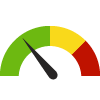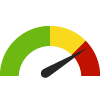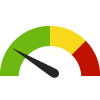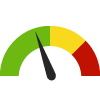Search for Indicators
Early Childhood
Indicator Gauge Icon Legend
Legend Colors
Red is bad, green is good, blue is not statistically different/neutral.
Compared to Distribution
 the value is in the best half of communities.
the value is in the best half of communities.
 the value is in the 2nd worst quarter of communities.
the value is in the 2nd worst quarter of communities.
 the value is in the worst quarter of communities.
the value is in the worst quarter of communities.
Compared to Target
 meets target;
meets target;  does not meet target.
does not meet target.
Compared to a Single Value
 lower than the comparison value;
lower than the comparison value;
 higher than the comparison value;
higher than the comparison value;
 not statistically different from comparison value.
not statistically different from comparison value.
Trend

 non-significant change over time;
non-significant change over time; 
 significant change over time;
significant change over time;  no change over time.
no change over time.
Compared to Prior Value
 higher than the previous measurement period;
higher than the previous measurement period;
 lower than the previous measurement period;
lower than the previous measurement period;
 no statistically different change from previous measurement period.
no statistically different change from previous measurement period.
Region: Greater Hampton Roads (MSA)
Maternal/Infant Health
Value
Compared to:
Region: Greater Hampton Roads (MSA) Children with Health Insurance
Region: Greater Hampton Roads (MSA) Children with Health Insurance
96.2%
(2021)
Compared to:




U.S. Counties
The distribution is based on data from 3,140 U.S. counties and county equivalents.

Prior Value
(96.2%)
Prior Value compares a measured value with the previously measured value. Confidence intervals were not taken into account in determining the direction of the comparison.

Trend
This comparison measures the indicator’s values over multiple time periods.<br>The Mann-Kendall Test for Statistical Significance is used to evaluate the trend<br>over 4 to 10 periods of measure, subject to data availability and comparability.
Region: Greater Hampton Roads (MSA)
Social Environment and Family Structure
Value
Compared to:
Region: Greater Hampton Roads (MSA) Children in Single-Parent Households
Region: Greater Hampton Roads (MSA) Children in Single-Parent Households
30.8%
(2018-2022)
Compared to:




U.S. Counties
The distribution is based on data from 3,132 U.S. counties and county equivalents.

US Value
(24.9%)
The regional value is compared to the national value.

Trend
This comparison measures the indicator’s values over multiple time periods.<br>The Mann-Kendall Test for Statistical Significance is used to evaluate the trend<br>over 4 to 10 periods of measure, subject to data availability and comparability.
Region: Greater Hampton Roads (MSA)
Nutrition
Value
Compared to:
Region: Greater Hampton Roads (MSA) Child Food Insecurity Rate
Region: Greater Hampton Roads (MSA) Child Food Insecurity Rate
14.0%
(2018)
Compared to:



U.S. Counties
The distribution is based on data from 3,141 U.S. counties and county equivalents.

US Value
(15.2%)
The regional value is compared to the national value.
Region: Greater Hampton Roads (MSA)
Socioeconomic Stability
Value
Compared to:
Region: Greater Hampton Roads (MSA) Young Children Living Below Poverty Level
Region: Greater Hampton Roads (MSA) Young Children Living Below Poverty Level
16.6%
(2018-2022)
Compared to:




U.S. Counties
The distribution is based on data from 3,131 U.S. counties and county equivalents.

US Value
(18.1%)
The regional value is compared to the national value.

Trend
This comparison measures the indicator’s values over multiple time periods.<br>The Mann-Kendall Test for Statistical Significance is used to evaluate the trend<br>over 4 to 10 periods of measure, subject to data availability and comparability.
Region: Greater Hampton Roads (MSA) Children Living Below 100% Poverty Level
Region: Greater Hampton Roads (MSA) Children Living Below 100% Poverty Level
15.2%
(2018-2022)
Compared to:




U.S. Counties
The distribution is based on data from 3,132 U.S. counties and county equivalents.

US Value
(16.7%)
The regional value is compared to the national value.

Trend
This comparison measures the indicator’s values over multiple time periods.<br>The Mann-Kendall Test for Statistical Significance is used to evaluate the trend<br>over 4 to 10 periods of measure, subject to data availability and comparability.
Region: Greater Hampton Roads (MSA) Renters Spending 30% or More of Household Income on Rent
Region: Greater Hampton Roads (MSA) Renters Spending 30% or More of Household Income on Rent
52.2%
(2018-2022)
Compared to:





U.S. Counties
The distribution is based on data from 3,132 U.S. counties and county equivalents.

US Value
(49.9%)
The regional value is compared to the national value.

Trend
This comparison measures the indicator’s values over multiple time periods.<br>The Mann-Kendall Test for Statistical Significance is used to evaluate the trend<br>over 4 to 10 periods of measure, subject to data availability and comparability.

HP 2030 Target
(25.5%)

